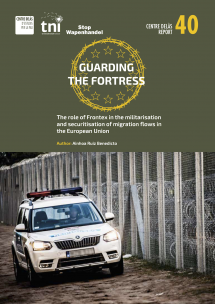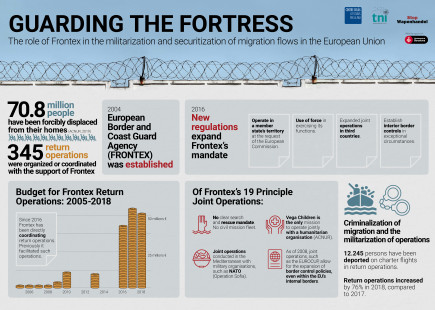Ideas into movement
Boost TNI's work
50 years. Hundreds of social struggles. Countless ideas turned into movement.
Support us as we celebrate our 50th anniversary in 2024.

The report focuses on 19 Frontex operations run by the European Border and Coast Guard Agency (hereafter Frontex) to explore how the agency is militarising borders and criminalising migrants, undermining fundamental rights to freedom of movement and the right to asylum.


This report is set in a wider context in which more than 70.8 million people worldwide have been forcibly displaced, according to the 2018 figures from the United Nations High Commissioner for Refugees (UNHCR) (UNHCR, 2019). Some of these have reached the borders of the European Union (EU), seeking protection and asylum, but instead have encountered policy responses that mostly aim to halt and intercept migration flows, against the background of securitisation policies in which the governments of EU Member States see migration as a threat. One of the responses to address migration flows is the European Border and Coast Guard Agency (hereafter Frontex), established in 2004 as the EU body in charge of guarding what many have called ‘Fortress Europe’, and whose practices have helped to consolidate the criminalisation of migrants and the securitisation of their movements.
The report focuses on analysing the tools deployed by Fortress Europe, in this case through Frontex, to prevent the freedom of movement and the right to asylum, from its creation in 2004 to the present day.
The sources used to write this report were from the EU and Frontex, based on its budgets and annual reports. The analysis focused on the Frontex regulations, the language used and its meaning, as well as the budgetary trends, identifying the most significant items – namely, the joint operations and migrant-return operations.
A table was compiled of all the joint operations mentioned in the annual reports since the Agency was established in 2005 up to 2018 (see annexes). The joint operations were found on government websites but were not mentioned in the Frontex annual reports. Of these operations, we analysed those of the longest duration, or that have showed recent signs of becoming long-term operations. The joint operations are analysed in terms of their objectives, area of action, the mandates of the personnel deployed, and their most noteworthy characteristics.
Basically, the research sought to answer the following questions: What policies are being implemented in border areas and in what context? How does Frontex act in response to migration movements? A second objective was to analyse how Frontex securitises the movement of refugees and other migrants, with the aim of contributing to the analysis of the process of border militarisation and the security policies applied to non-EU migrants by the EU and its Member States.